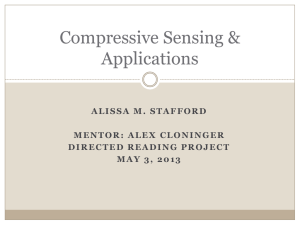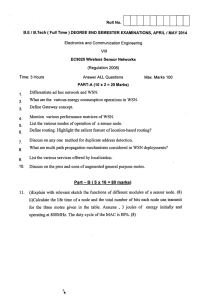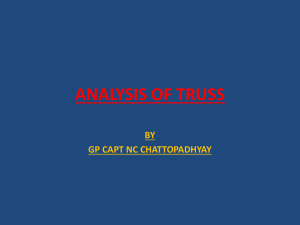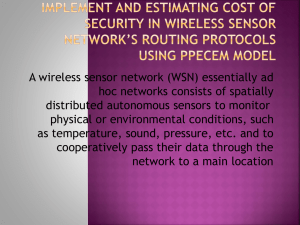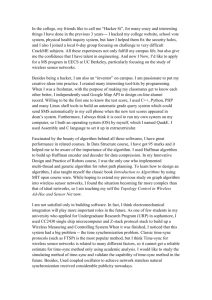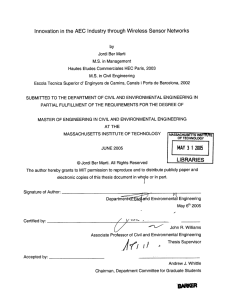2 nd - When noise is considered please do the following
advertisement
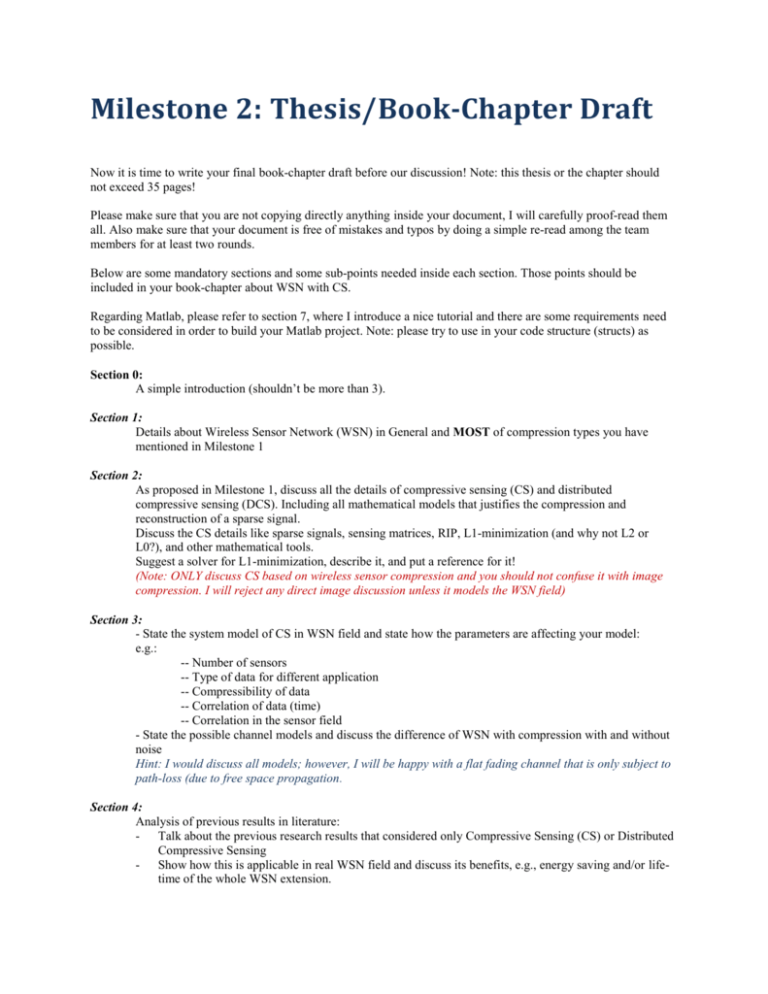
Milestone 2: Thesis/Book-Chapter Draft Now it is time to write your final book-chapter draft before our discussion! Note: this thesis or the chapter should not exceed 35 pages! Please make sure that you are not copying directly anything inside your document, I will carefully proof-read them all. Also make sure that your document is free of mistakes and typos by doing a simple re-read among the team members for at least two rounds. Below are some mandatory sections and some sub-points needed inside each section. Those points should be included in your book-chapter about WSN with CS. Regarding Matlab, please refer to section 7, where I introduce a nice tutorial and there are some requirements need to be considered in order to build your Matlab project. Note: please try to use in your code structure (structs) as possible. Section 0: A simple introduction (shouldn’t be more than 3). Section 1: Details about Wireless Sensor Network (WSN) in General and MOST of compression types you have mentioned in Milestone 1 Section 2: As proposed in Milestone 1, discuss all the details of compressive sensing (CS) and distributed compressive sensing (DCS). Including all mathematical models that justifies the compression and reconstruction of a sparse signal. Discuss the CS details like sparse signals, sensing matrices, RIP, L1-minimization (and why not L2 or L0?), and other mathematical tools. Suggest a solver for L1-minimization, describe it, and put a reference for it! (Note: ONLY discuss CS based on wireless sensor compression and you should not confuse it with image compression. I will reject any direct image discussion unless it models the WSN field) Section 3: - State the system model of CS in WSN field and state how the parameters are affecting your model: e.g.: -- Number of sensors -- Type of data for different application -- Compressibility of data -- Correlation of data (time) -- Correlation in the sensor field - State the possible channel models and discuss the difference of WSN with compression with and without noise Hint: I would discuss all models; however, I will be happy with a flat fading channel that is only subject to path-loss (due to free space propagation. Section 4: Analysis of previous results in literature: - Talk about the previous research results that considered only Compressive Sensing (CS) or Distributed Compressive Sensing - Show how this is applicable in real WSN field and discuss its benefits, e.g., energy saving and/or lifetime of the whole WSN extension. Section 5: MATLAB model! Please, find on the GUC intranet/eee one of the simplest wireless sparse generator in time and frequency with my modification. This code I also modified to calculate the MSE. The file name: WSN_CS_Khaled.zip The file contains: 1- Two pdf matlab simple tutorials 2- L1-magic software tool 3- Compressive_Sensing directory which contains the matlab files that perform CS and reconstruction are named after: a. Compressive_Sensing3.m: a simple sparse generator and l1-minimization solving using a DFT matrix as a sensing random matrix (A) b. Compressive_Sensing_DCT/DFT.m : generates a signal in time which is sparse in frequency, then changes the signal to frequency and perform CS. c. Compressive_SensingTime_DCT/DFT.m; the same but sprase in time!!! PLEASE USE this one as it is the fastest (mainly DCT) and the more accurate (i.e., lower MSE, especially DCT). Office hours for project, next week on Sunday, Monday, and Wednesday (full day). Please do the following in your matlab: - Define a single hop WSN with number of sensors N =1024 - Define the WSN field to be of an area of 0.5 Km x 0.5 Km - Assume that the fusion center is in the middle of this field - Assume you have only free-space path-loss model = 10*log10(d^2) - Assume that each sensor generates the same maximum power = 100mW - Assume that all sensors reach the fusion center without interference of the other sensors (i.e., perfect scheduler and MA[e.g., TDMA/FDMA] are assumed - Assume that each sensor produces 1024 sample measurements which are sparse somehow - Finally, show that collecting the data with fewer random samples (M << N) can reconstruct the original 1024 samples with low MSE. Firm deadline: 15.12.2013 You may add to your references: [1]- T. Srisooksaia, K. Keamarungsib, P. Lamsrichanc, and K. Arakid, “Practical data compression in wireless sensor networks: A survey,” Journal of Network and Computer Applications, Volume 35, Issue 1, January 2012, Pages 37–59 [2]- http://www-micrel.deis.unibo.it/aigaion2/index.php/attachments/single/76 --Clarifications: For the sensor compression, we will consider two mandatory cases to compute the MSE: 1st - Without Noise; and here the signal power and the Path-loss are irrelevant. This means you can either neglect them or do the following: y = Ax, (this is done at the transmitter) (1) Then the transmitter converts the data at the output of the RF mixer to an analog data with the maximum transmit power Pt, such that: y' (after the radio front end at the Tx) = y * Pt. (2) Thereafter, it should be scaled by pathloss (which is [in dB]: PL|dB = 10*log10(d^2). IMPORTANT: PLEASE, change it to linear scale). This means that the signal will be affected as follows: y’’ = y’ * 1/PL (linear not dB). (3) At the receiver, the signal will be re-amplified to return it to the original values such that: yr = y’’ * PL / Pt, (4) where the multiplication by the pathloss “PL” (linear and not dB) is equivalent to an amplification and the scaling by the Pt is a normalization. ** Now you can recover the original x from yr! 2nd - When noise is considered please do the following: - Generate a white Gaussian noise with the same length of the data vector of each sensor and with the variances: -40 and -90 dBm (please change it to the linear scale first) Add the random Gaussian noise to equation (4) as follows: o yr = (y’’+ noise)*PL/Pt (5) o Now you can recover the original x from yr (in equation (5))! NOTE: The disadvantage of the noise is very clear here! YOU cannot amplify the signal without amplifying the noise with (exactly) the same amount. Therefore, the signal-to-noise ratio will stay always constant after multiplying by (PL/Pt), i.e., noise cannot be withdrawn from the system.
